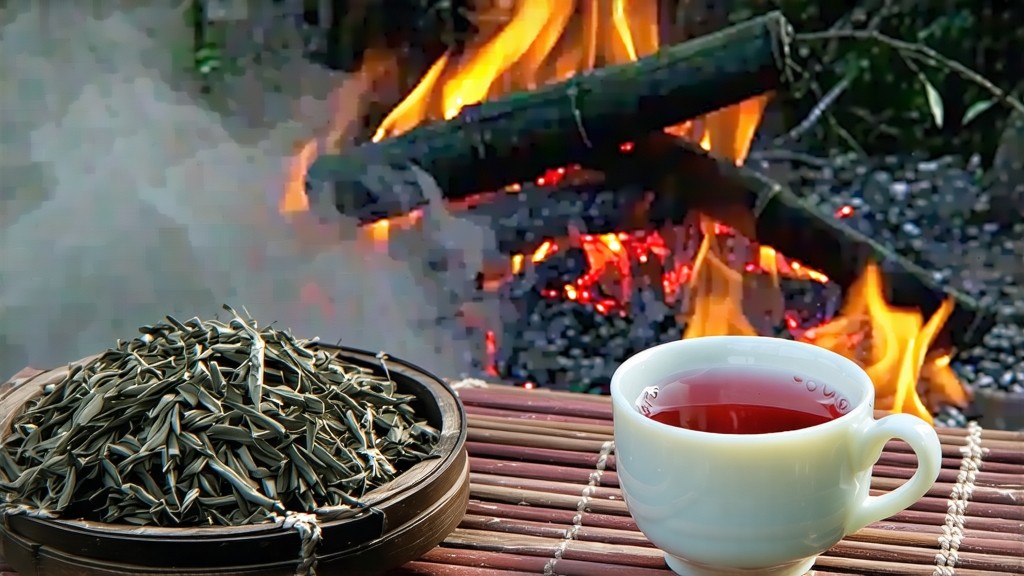
Long before Assam, Ceylon or Earl Grey entered the English lexicon, the words “bohea” and “souchong” were scribbled in the ledgers of 17th-century East India Company captains. Those terms referred to one place—Tongmu Guan, a tiny ravine tucked into the Wuyi Mountains of northern Fujian—and to one tea, today baptised Lapsang Souchong. International writers often treat it as a curiosity because of its smoky perfume, yet for Chinese tea historians it is simply hong cha (red tea), the primordial style that launched the global black-tea trade. To understand Lapsang Souchong is to hold a keyhole through which the entire saga of Chinese red tea can be glimpsed: imperial tribute, maritime opium clippers, European porcelain crazes, and modern gongfu revival.
Legend fixes the birth year at 1568, late-Ming, when passing soldiers commandeered a tea workshop and forced farmers to dry leaf overnight over green pinewood. By morning the tea was blackened and fragrant; the accidental batch was rushed down-river to the port of Xingcun, purchased by Dutch agents, and re-sold in Amsterdam as “the Chinese drink that warms the blood.” Whether myth or marketing, the story underlines two constants: the leaf is withered and fired over resinous pine, and it has always been made for export.
Geography explains why. Tongmu sits at 27° N, 700–1,200 m above sea level, where subtropical mists rise from the Jiuqu (Nine-Bend) Stream and condense against cliffs of volcanic tuff. The soil is poor, stony, and laced with minerals that force the tea bush—here the small-leaf cultivar Caicha or Wuyi Qizhong—to struggle, concentrating sugars and volatile aromatics. Nights are cool even in May, so the withering shed becomes a micro-climate: bamboo trays stacked like organ pipes above smouldering pine embers, the smoke drifting upward through slatted floors. No other region is legally allowed to call its smoked tea “Zheng Shan Xiao Zhong” (Original Mountain Small Sort), a 2002 Chinese geographical indication that mirrors Champagne in France.
Farmers recognise three traditional grades. First, Wu Shan (Original Mountain), picked in late April from bushes seeded before 1950, consisting of one bud and two leaves, lightly smoked for eight hours; the cup is burgundy, the aroma a whisper of pine that yields to longan fruit and honey. Second, Wai Shan (Outer Mountain), harvested from clonal terraces beyond the protected core, given a heavier 12-hour smoke to mask broader, less complex leaf; this is the version most Europeans met in supermarket tins. Third, Unsmoked or “Zheng Shan” Xiao Zhong, a 21st-century innovation requested by Fujian exporters seeking a cleaner profile for the domestic market; it is processed likeorthodox black tea but withered above charcoal instead of pine, yielding malt, cacao and dried-rose notes.
Craft begins the moment pickers lay leaf into bamboo baskets at dawn. The first four hours are a quiet wither in the open courtyard, where mountain breeze reduces moisture to 65 %. Then the leaf enters the louqing (smoke-withering) loft: pinewood logs, 30 cm long, are burned down to embers, never flame, and smothered with fresh sawdust to create a cool, aromatic smoke (< 40 °C). Craftsmen shuffle the trays every 20 minutes so each leaf inhales the same measure of guaiacol and syringol, the phenols responsible for the tea’s signature campfire scent. Once the leaf is velvety and pliable, it is rolled for 45 minutes on a cast-iron trough lined with bamboo; cell walls rupture, enzymes meet substrates, and the sap oxidises from grassy to biscuity. Oxidation itself is brief—only two hours—because the pine smoke arrests enzymatic activity early, fixing a russet colour and locking in sweetness. Finally the leaf is given a “second life” over a hotter pine fire (80 °C) to reduce moisture to 4 %, then rested in earthen jars for 30 days so smoke and tea oils marry.
To brew Lapsang Souchong well is to balance its drama. Western infusers often drown the leaf in boiling water and emerge with a cup